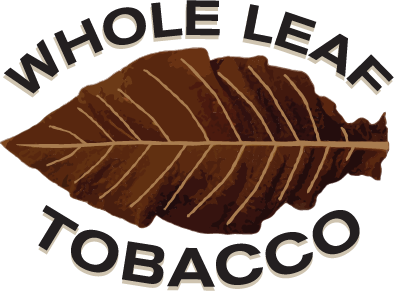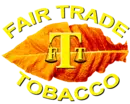Tobacco Jargon
Over the centuries, terminology used by tobacco growers and the tobacco industry has accumulated into a set of words that make perfect sense to insiders, but can be vague, ambiguous and even misleading to those not a part of it. While cigars, pipes, pipe tobacco, cigarettes and smokeless tobacco also have their unique terms (discussed in their sections), only general tobacco terms are covered here. Keep in mind that nearly every variety of Nicotiana tabacum (so-called smoking tobacco) can and probably has been used for nearly every kind of tobacco use or product.
These semi-official USDA ARS-GRIN classes are vaguely useful in deciding what tobacco leaf variety to grow or obtain for a specific purpose. Those classes that are use-based, are indications of the predominant use, in the late 19th century, of specific varieties by the manufacturers of various tobacco products or by exporters. They do not indicate the exclusive applications for a particular class of tobacco. The geographic classes are mostly of historic interest, since nearly all varieties of tobacco can be (and are) grown in most regions of the world.
Burley
Burley, as a group of tobacco varieties, is predominantly derived from Ohio White Burley, which in 1864 was an accidental genetic variant discovered in a seedbed of the now lost “Red Burley.” Burleys tend to have lighter or cream-colored stalks and veins while growing, and produce a large, relatively smooth leaf that quickly color-cures to a bright yellow, then dries to a light brown. Burley seedlings are often fragile, and transplants are more tender and slow to establish. For most of its growth, the leaves are held upright, near the stalk, with a close distance between the leaf nodes. In contrast to this, once well established, it lengthens rapidly, and may mature earlier than other varieties. It is often stalk harvested when fully ripe, though primed leaf can make excellent cigar wrappers and binders. Burley is historically air-cured, and can be cured by any of the other curing methods, though flue-curing produces unimpressive results. Burley leaf tends to be low in carbohydrates, and relatively high in nicotine. Burley tobacco, when smoked, offers a distinctive and recognizable aroma.
Uses: Cigarettes, pipe blending, chewing. Most commercial Burley is used in blending cigarette tobacco (together with Flue-Cured, sometimes a small percentage of Oriental, and occasionally with Perique). Primed lower leaves make fine, light-colored cigar wrappers, and most Burley leaf is sufficiently sturdy to serve as cigar binder
Cigar Binder
Binder is a diverse class of tobacco varieties that tend to produce a leaf with sufficient elasticity and tensile strength to withstand the stress of compressing a bunch of cigar filler. Some of these varieties are nearly identical to varieties classified as Cigar Filler. Their flavors, aromas and burn qualities are not a consideration in classification.
Uses: Cigar wrapper, cigar binder, cigar filler, pipe blending, chew. When air-cured or flue-cured, cigarette blending.
Cigar Filler
Since most tobaccos can be used as cigar filler, this formal class includes only those that found a major market as filler with cigar manufacturers, either in the U.S., or in its primary growing regions. Varieties that regularly produce leaves which are thick or corrugated or intensely rippled are unsuitable for use as wrapper or binder, since they can not be flattened. Some of these varieties are nearly identical to varieties classified as Cigar Binder.
Uses: Cigar filler, pipe blending, chew. Finer leaves can be used as cigar binder or even cigar wrapper. Wrapper and Binder varieties that are damaged are frequently used as filler. When air-cured or flue-cured, cigarette blending.
Cigar Wrapper
Wrappers for cigars require a leaf (or portion of a leaf) that is without flaws, both for reasons of air flow as well as aesthetics. While some are preferred to be thin, such as Connecticut Shade leaf and Indonesian Sumatra, others are noticeably thicker, such as Ecuador Sumatra, Connecticut Broadleaf, and most wrapper leaf that is grown in full sun. Some varieties naturally attract fewer insects (or more effectively repel them) that make pinholes in the lamina. Shade-grown wrappers (grown beneath a canopy of shade cloth) are larger, thinner, more fragile and less intensely flavored than sun-grown wrappers. Ideally, wrapper leaf burns to a white ash. Some traditionally shade-grown tobacco varieties can be successfully grown without shade.
Uses: Cigar wrapper, cigar binder, cigar filler, pipe blending, chew. When air-cured or flue-cured, cigarette blending.
Dark/Air Cured
These typically have very dark green, thick, sticky leaves. They air-cure to a strong, intensely flavored leaf.
Uses: Chew, snuff, cigarette blending.
Flue-Cured
This is the primary tobacco used in manufactured cigarettes. Often generically called, “Virginia,” these tobaccos were selected to be effectively and rapidly flue-cured (by heat alone, in the absence of smoke) to a bright yellow or deep gold color. That curing process results in a leaf that produces acidic smoke, and ages very little, thereby maintaining the bright color. All flue-cured varieties can be successfully cured using any available curing method.
Uses: Cigarette blending, pipe blending. When air-cured and fully finished, can be used for cigar wrapper, cigar binder or cigar filler.
Fire-Cured
Fire-cured varieties tend to produce dark, heavy, sometimes sticky leaves that can endure a multi-week exposure to both the heat and the smoke of open curing fires. The resulting leaf is tough, darkened, and gives off a distinct smoky aroma and taste. The fire-curing process yields a leaf that is high in nicotine, and sometimes does not burn well.
Uses: Chew, snuff, cigarette blending. Blended in some Appalachian-style cigars and stogies. Sometimes used in pipe blending.
Hungarian
This wide-ranging collection of tobaccos has its origins in the tobaccos grown within the many Eastern European member states of the Austro-Hungarian Empire. There is no distinctive characteristic of the class. [It would be similar grouping the numerous varieties of tobacco grown in the U.S. to an “American” tobacco class.] Some are strong, some are mild.
Uses: Any tobacco applications, depending on the specific variety.
Maryland
These tobaccos resemble the large, seedleaf varieties, from which they are derived, though they tend to be mild, the nicotine concentration may or may not be high. They are traditionally stalk-harvested and air cured, and often used to increase the flavor-holding capacity of an aromatic blend.
Uses: Pipe blending, cigarette blending. Can be used as mild cigar wrapper / binder / filler.
No Type
This class was applied by USDA ARS-GRIN personnel to indicate “unidentified” class. These are generally GRIN accessions received from undeveloped geographic regions, and received without adequate documentation.
Oriental
“Oriental” is a term for tobaccos that, in the early twentieth century, were often labeled as “Turkish.” These initially reached the Middle-East, Iran, India and Indonesia via Dutch and Portuguese traders soon after the first arrival of tobacco in Europe (~1500). Many derivatives were cultivated in wide-ranging areas within the Ottoman Empire. Today, these are frequently grown in Macedonia, Greece, Bulgaria, Turkey and the Republic of Georgia. Oriental tobaccos have a reputation for being small-leafed, delicate, aromatic and low in nicotine. This is true of some, though not all. Oriental tobaccos are traditionally sun-cured, though they are successfully cured by any of the available curing methods. Latakia, grown in Syria and Cyprus, is an indeterminate Basma-like variety that is intensely fire-cured in the smoke of aromatic herbs and scrub typical of the Mediterranean basin.
Uses: Cigarette blending, pipe blending. The larger leaf Oriental varieties can be used as cigar wrapper, cigar binder, cigar filler.
Other
This ARS-GRIN class may be considered as “no information available”
Primitive
These are varieties that, according to the classifier at ARS-GRIN, appeared to definitely be Nicotiana tabacum, but to have been subjected to little or no agricultural improvement effort, in comparison to the hypothetical “wild” type. Their splayed venation patterns may make it difficult to utilize as cigar wrapper or cigar binder. Some have distinctive, sometimes odd, aromas and flavors. Some make excellent and rich cigar filler and cigarette blending leaf.
Fire-curing barn. [Workman Tobacco Seed Company]
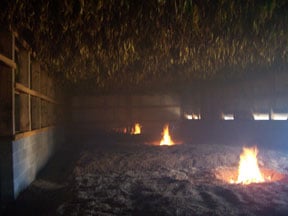
This is an indication of how intact an individual leaf is found to be, following curing and any additional finishing processes. It also takes into account the general size of the leaf (as relates to suitability for a particular use), the overall color of the leaf, and the consistency of that color over the entire leaf surface. Usually, the “higher” the grade, the greater the market value (cost) of the leaf. But this does not limit its use for purposes not indicated by its “grade”.
Wrapper
Generally, though not necessarily, a larger leaf that is almost entirely free of small holes or tears. The various leaf grades (there are well over a dozen) assess the tensile strength, stretch and the thickness of secondary veins, since their intended use is for the visible, exterior of a cigar or plug.
Binder
A binder requires a greater tensile strength than does a wrapper, since it must contain most of the compression force surrounding a cigar‘s filler bunch. Binders may have occasional, small holes and non-critical tears. Binders are often, though not all, thicker than wrappers.
Filler
The leaves of most cigar types of tobacco that are not intact enough to be used as wrapper or binder are graded as “filler”. Leaf graded as filler may contain the entire stem (central vein), or be frog-legged, by removal of only the thicker portion of the stem.
Broken leaf and pieces
This is exactly what it says. Some is used in applications of shredded tobacco, while other is used for chemical extraction of the nicotine in industrial applications
There are over 3000 documented varieties of Nicotiana tabacum. They are all the same species, like domesticated dogs, but show a continuum of characteristics, depending on their genetic heritage. While “Virginia tobacco” may refer to a host of different varieties of tobacco intended to be flue-cured, Virginia Bright Leaf for example, is the name of a specific variety. While “burley” is a market class of tobacco, Tennessee 89 (or TN 89) is a specific variety of burley, and different from TN 90. Varieties are being continually developed to alter various characteristics, such as specific disease resistance or dominance of nicotine production over that of nornicotine.
Smoking tobacco
Common smoking tobacco, and the general tobacco of world commerce is exclusively Nicotiana tabacum, which originated along the eastern slopes of the Andes mountains, and spread into all of South America and the Caribbean. Different varieties of N. tabacum are now successfully grown throughout the world, including Nepal, Scandinavia, the Alps, and on every continent except Antarctica. With the ability to start seed indoors, and then transplant outdoors after about 8 weeks, and to cure green-harvested tobacco indoors as well, tobacco can be successfully grown in any location that experiences a vegetable growing season of at least 70 to 80 days. Shorter season varieties also exist.
Rustica
The cultivated, Native American tobacco of the regions stretching from Mexico north-eastward, into the Mississippi valley, and as far as southeastern and south-central Canada was Nicotiana rustica. N. rustica will propagate itself to a very limited extent, but it is not wild, and will not persist after more than a few years. Its millennia of intentional, human cultivation and selection limited its ability to adequately disperse its own seed spontaneously, though it does so more efficiently than N. tabacum.
Wild tobacco species
In the upper mid-west of the US, the west coast, and up into western Canada, several other species were used and sometimes traded, but these were and continue to be wild species (e.g. N. quadrivalvis, N. bigelovii, N. attenuata) that generally propagate themselves without human intervention−though they were sometimes intentionally cultivated. Blending with a portion of N. rustica is used today in cigarette manufacture in some countries in Eastern Europe and elsewhere, to increase nicotine concentrations. Continued consumption of wild species is generally limited to ceremonial uses.
North American Nicotiana species
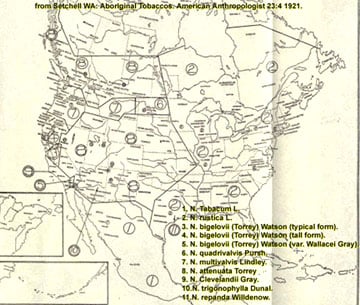
This is a quite old tobacco term that vexes most people unfamiliar with its use. With regard to tobacco, it is a statement of its moisture content. Out of case describes tobacco that is so dry that it crumbles to fragments and dust when handled in any way. In case describes tobacco that contains a high enough moisture content that it can be easily handled, without damaging the leaf. With regard to users of whole leaf tobacco, there are four general levels of case:
Out of Case
very noisy, like dried autumn leaves, and crumbles when handled
Low Case
much quieter, is mostly flexible, though it may crack slightly
Medium Case
sounds like thick vinyl, is entirely flexible, and has a moderate stretch'
High Case
silent, feels somewhat moist, though not wet, is flexible and fully stretchy
This is different from case. Casing is a liquid preparation that is added to tobacco to alter its taste or aroma, or to improve its ability to retain moisture and hold flavorings. Some may contain simple chemicals, such as citric acid. Flavor casings may include essential oils, which are either alcohol-based or polypropyleneglycol (PPG) based. They may also be common food flavorings, such as honey or syrup or brandy or other commercial alcohol product. Casings that are not intended to alter the flavor or aroma, but rather to increase the hygroscopic (water holding) nature of the tobacco include PPG or glycerin, or both. PPG also acts an a mold inhibitor, while glycerin is mildly bacteriostatic. These latter casings are what allow commercially distributed cigarettes or especially pipe tobacco to retain their soft, look and feel for months or years on the shelf. Essential oils alone tend to rapidly lose their aroma, in the absence of PPG. It is PPG that permits so-called black Cavendish to remain black in appearance, instead of its natural deep brown. PPG does not impact aroma, but it does affect the taste of tobacco.
Living tobacco leaf contains several enzymes that continue to function after the leaf has dried and died. These oxidize carbohydrates and proteins, and are a primary cause of what we identify as aging in finished tobacco. The speed at which these chemical changes occur is dependent on temperature and the presence of moisture. Many different methods can be used to increase the speed of this process, though it still may require as long as several years to run to near completion. This is why “aged” leaf usually seems “better” than leaf with less age. Basic tobacco fermentation−aging−does not depend on the action of microbes, though they may influence subtle characteristics late in the aging process.
In the distant as well as the recent past, all whole leaf tobacco of commerce was tied into bundles of 20 or 30 similar leaves, using an additional leaf as the “tie” or wrap at the stem end of the bundle. These so-called hands of tobacco could be more efficiently handled, packed into bales or wooden hogsheads (huge, squat barrels) for transport by wagon or ship, and subsequently handled after unpacking.
Tied hands of tobacco
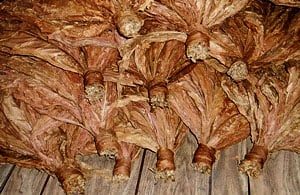
Meaning 1
The perique process and the unique tobacco that it produces go by the same name, perique.It is produced by applying pressure (~35 psi) to leaf that is sealed beneath liquid, rendering it mostly oxygen free. This is continued for several months, allowing anaerobic microbes (namely the yeast,Pichia anomala) to dominate the microbial culture. Perique tobacco is dark in color, relatively strong, and creates a slightly alkaline smoke when burned. This is the Perique that is commonly blended with flue-cured Virginia tobacco to make Virginia−perique pipe blends.
Meaning 2
By contrast, a periqueof tobacco (in the same sense as a plug of tobacco), and also known as a carrotte of tobacco, is a cylinder of tobacco that has been tightly wrapped within a coil of rope to compress it and preserve it. These were popular with sailors during the early nineteenth century, as a way to keep tobacco smokable during long ship voyages. The character of the tobacco resembles twist-rope or pressed plug, more than pressure-processed perique tobacco.
Cigar thickness is often stated as a ring gauge, because, over the centuries, cigar factories would sort their hand-rolled cigars by thickness (diameter), using a wooden plank with smooth, carefully calibrated holes into which the end of a cigar could be passed. Ring gauge is a measure of 64ths of an inch. So a 64 ring cigar has a 1 inch thickness or 1 inch diameter. A 32 ring cigar is 1/2 inch thick. Likewise a 48 ring is 3/4 inch.
Example of a ring gauge tool, not shown actual size.

